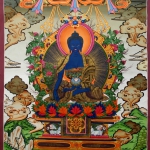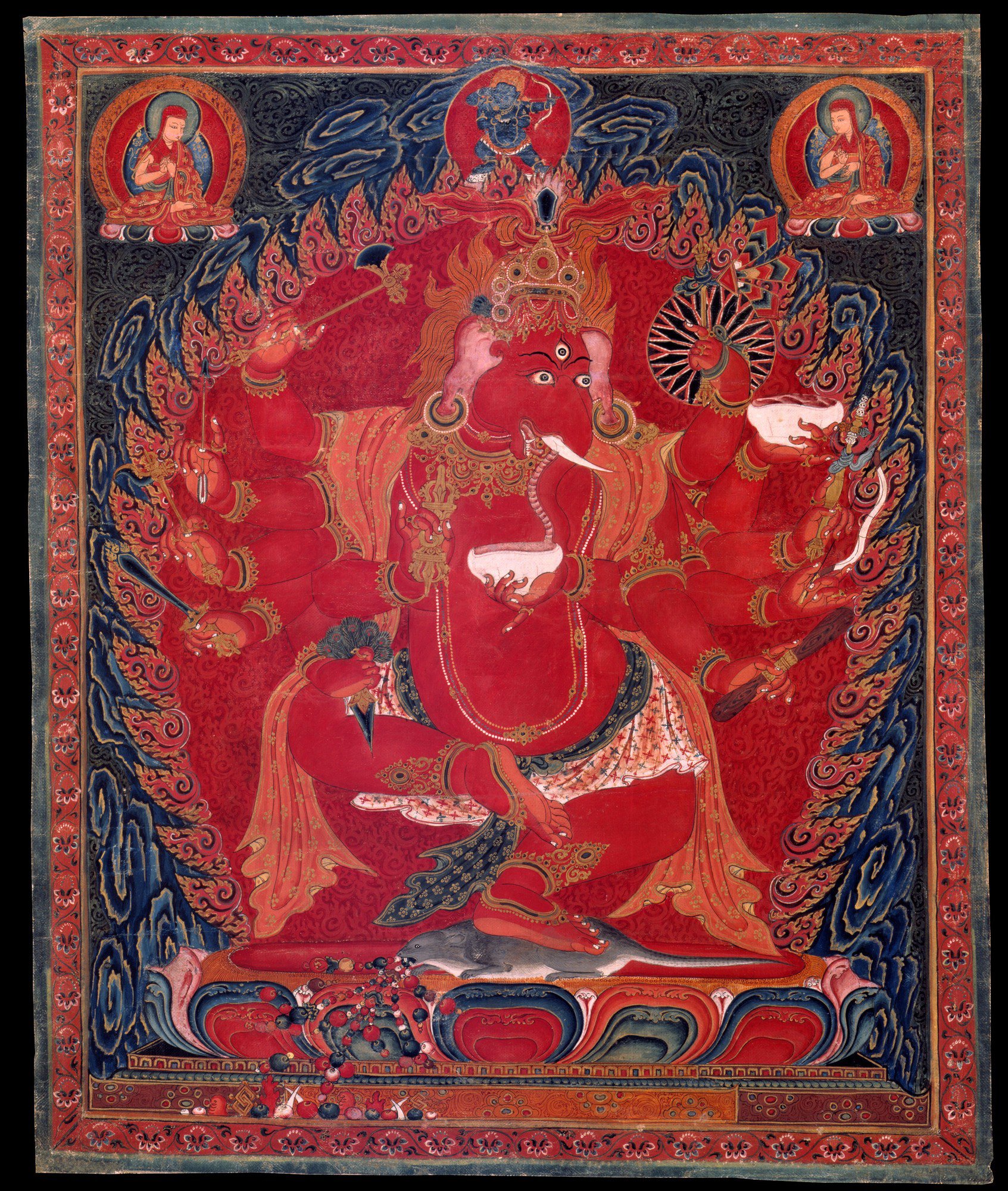Explaining Ganapati Thangka – the Great Red Lord of Hosts
Ganapati is one of the best-known and most worshipped deities in the Hindu pantheon. Ganapati is also known as the Great Red Lord of Hosts. Ganesh originated with Brahmanism (Vedism). In Buddhism, there are two sutras that mention Ganapati, and one with his “Dharani” (mantra) which can be chanted by anyone. In the sutra, Buddha says:
Any son or daughter of high birth, whether monk or nun, lay brother or sister who undertakes any matter accomplishing the rites to call a sacred being by means of mantras, worshipping the Three Jewels, traveling to another country, going to the royal court or concealing should upon worshipping the Blessed Buddha, practice seven times the Arya Ganapati Hrdaya: for him, all tasks will be accomplished; no doubt about this!
Table of Contents
The Viability of the Ganapati
In this portion, we are going to grab about the viability of the Ganapati. After that, we will learn about the short etymological description of Ganapati itself. Eventually, we will highlight about Spiritual power of the Ganapati.
Etymology of the Ganapati
The meaning of Ganapati is tsog gi dag PO, mar Chen in Tibet.
Ganapati is called the Tantric Buddhist form of Ganapati related to the Chakrasamvara Cycle of Tantras.
Spritual power of Ganapati
Ganapati is known as Ganesh and Vinayaka who is one of the best-known and most worshipped deities in the Hindu pantheon.
Ganapati’s image is found throughout India, Nepal, Sri Lanka, Fiji, Thailand, Mauritius, Bali, and Bangladesh.
Hindu denominations worship him regardless of affiliations and devotion to Ganesha is widely diffused and extends to Jains and Buddhists. This form of Ganapati is regarded as an emanation of Avalokiteshvara.
Earlier, we studied the viability of the Ganapati. Now we are going to learn about the iconography of the Ganapati.
Iconography of the Ganapati
In the iconography of the Ganapati, we will go through his body posture, hand and leg gesture, and different representations of Ganapati in thangkas and statues.
Posture of the Ganapati
Ganapati stays beside a lapis lazuli rock mountain is a red lotus with eight petals in the middle a blue rat expelling various jewels.
Shri Ganapati is with a body that is red in color having an elephant face with sharp white tusks and possessing three eyes.
Ganapati is with black hair tied in a topknot with a wishing-gem and a red silk ribbon in a bundle on the crown of the head.
Ganapati has twelve hands. The six right hands of Ganapati holds an ax, arrow, hook, vajra, sword, and spear.
The six left hands of Ganapati hold a pestle, bow, katvanga, skullcup filled with blood, skullcup filled with human flesh, and a shield together with a spear and banner.
The peaceful right and left hands of Ganapati are signified by the vajra and skullcup filled with blood held to the heart.
The remaining hands of Ganapati are displayed in a threatening manner. Ganapati is wearing various silks as a lower garment and adorned with a variety of jewel ornaments.
The left foot of Ganapati is extended in a dancing manner. He is standing in the middle of the bright rays of red flickering light.
This form of Ganapati belongs to a set of three powerful deities known as the ‘mar Chen kor sum’ or the Three Great Red Deities included in a larger set called ‘The Thirteen Golden Dharmas’ of Sakya. The other two deities are Kurukulla and Takkiraja.
Earlier, we studied the viability of the Ganapati and iconography of the Ganapati. Now we are going to learn about depicting Ganapati.
Depicting Ganapati Thangka
The thangka of Ganapati is from Tibet. It is made between 15 AD to 1599 AD. Ganapati is from Ngor, Sakyaand Buddhist lineage. The base of the painting is ground mineral pigment on cotton. Presently, it is in the Rubin Museum of Art.
By depicting this thangka, we are going to learn about the presentation of Ganapati with Bhutadamara Vajrapani, and Vajrapanjara Tantra and the Bhutadamara Tantra, etc.
Bhutadamara Vajrapani
Bhutadamara Vajrapani is at the top center of the thangka. Bhutadamara Vajrapani is blue in color. Bhutadamara Vajrapani is wrathful.
This is a non-standard form of the meditational deity Bhutadamara who is typically depicted performing the ‘Bhutadamara’ demon subduing gesture with both hands at the level of the heart.
Bhutadamara is also holding a vajra in the upraised right hand and a vajra lasso in the left hand.
Vajrapanjara Tantra and the Bhutadamara Tantra
Vajrapanjara Tantra and the Bhutadamara Tantra both describe the deity as performing the mudra.
The origins of the Bhutadamara associated with Maharakta Ganapati are so far not explained.
Also at the top right and left of the thangka, there are two figures wearing monastic attire and red Pandita hats typical of the Sakya and Ngor schools of Tibetan Buddhism.
The hand attributes for each are a vajra and bell. The figures are unidentified and no inscriptions are found below the figures or on the back of the painting.
Earlier, we studied the viability of the Ganapati, iconography of the Ganapati, and depicting Ganapati. Now we are going to learn about the lineage of the Ganapati.
The lineage of the Ganapati
Now we are going to learn about the lineage of the Ganapati.
The source text used in the Sakya Tradition was taught by the Mahasiddha Krishnacharin and translated by Pandita Gayadhara.
It is a little odd that those two do not appear in the official lineage of teachers. The lineage of Ganapati is listed below:
- Vajradhara
- Vajra Varahi
- Sarah
- Nagarjuna
- Lord Shavaripa
- Hangdu Karpo
- Mal Lotsawa
- Sachen Kunga Nyingpo
Previously, we studied the viability of the Ganapati, the iconography of the Ganapati, depicting Ganapati, and the lineage of the Ganapati. Now we are going to learn about the presentation of Ganapati with Padmasambhava.
Ganapati with Padmasambhava Thangka
Ganapati with Padmasambhava was painted around 1800-1899 AD. The size of this painting is 28.58×21.59cm. The base of the painting is cotton and the ground mineral pigment is used to color it. Ganapati belongs to Nyingma and Buddhist Lineage. This Masterpiece Thangka Art is still preserved and kept in the Rubin Museum of Art.
By depicting this thangka we will learn about the presentation of Ganapati with different deities such as Four attendant retinue figures, Guru Padmasambhava, Ragavajra Ganapati, etc.
Ganapati is red in color with a white elephant head and four hands. He holds a plate of Indian sweets, a white radish, a string of mala beads, and a hook.
The heels of the feet are supported by the hands of a blue monkey-headed goddess that stands on the backs of two small goddesses.
Four attendant retinue figures
Four attendant retinue figures are red in color with one face and two hands held in the right a rope, hook, chain and bell.
The left hands of each hold a bow and lasso.
Guru Padmasambhava
Guru Padmasambhava is at the top center of the thangka.
Ragavajra Ganapati
Ragavajra Ganapati is known as glorious Ganapati. Ragavajra Ganapati’s body is white in color.
Ragavajra has three faces, the main face is that of an elephant, the right a mouse, the left a monkey.
With six arms the three right of Ragavajra Ganapati holds a vajra, turnip, and sword.
The three left hold sweets, a skullcup filled with alcohol, and a battle-ax. The two back legs of Ragavajra Ganapati are placed bent and the other extended.
The two inside legs are folded. He is adorned with jewels, a lotus garland, and naked.
Previously, we studied the viability of the Ganapati, the iconography of the Ganapati, depicting Ganapati, the lineage of the Ganapati, and the representation of Ganapati with Padmasambhava. Now we are going to learn about the presentation of Ganapati with Vaishavana.
Ganapati with Vaishavana Thangka
Ganapati with Vaishavana was painted around 1800-1899 AD. The size of this painting is 45.72×68.58cm. The base of the painting is cotton and the ground mineral pigment is used to color it. Ganapati belongs to Nyingma Lineage. This Masterpiece Thangka Art is still preserved and kept in the Rubin Museum of Art.
By depicting this thangka we will learn about the presentation of Ganapati with different deities such as Padmasambhava, Mongoose, and Binding Red Vaishravana, etc.
On the left side of the thangka, there is Guru Rinpoche Padmasambhava holding to the heart a gold vajra, the left placed in the lap supporting a skullcup.
At the top center of the thangka, there above wisps of cloud and the rainbow light is a standing Guru Rinpoche accompanied by two attendant goddesses who is holding aloft a parasol behind and waving a fragrant sensor in front.
Padmasambhava
Padmasambhava is on the right side of the thangka. Padmasambhava is performing the function of a wealth deity, Guru Rinpoche-Vaishravanawho is with one face and two hands holding in the right an upraised victory banner.
Mongoose
Mongoose is on the left side of the thangka and held in the lap. Mongoose is attired in the usual manner and is surrounded by the Eight Horseman of Vaishravana.
Binding Red Vaishravana
Binding Red Vaishravana is at the middle left of the thangka.
Red Vaishravana is with one face, three eyes, and two hands holding in the right upraised a victory banner and spear.
Previously, we studied the viability of the Ganapati, the iconography of the Ganapati, depicting Ganapati, the lineage of the Ganapati, representation of Ganapati with Padmasambhava. and representation of Ganapati with Vaishavana. Now we are going to learn about the presentation of Ganapati with Avalokiteshvara.
Ganapati with Avalokiteshvara thangka
The thangka of Ganapati with Avalokiteshvara is from Tibet. The base of the painting is cotton and the ground mineral pigment is used to color it. Ganapati belongs to Sakya and Kagyu Lineage. This Masterpiece Thangka Art is still preserved and kept in the Rubin Museum of Art.
By depicting this thangka we will learn about the Ganapati.
Ganapati, Maha Rakta is a tantric Buddhist form of Ganapati related to the Chakrasamvara Cycle of Tantras.
This form of Ganapati is regarded as an emanation of Avalokiteshvara.
Ganapati Who is known as Maha Rakta is beside a lapis lazuli rock mountain is a red lotus with eight petals in the middle a blue rat expelling various jewels.
Previously, we studied the viability of the Ganapati, the iconography of the Ganapati, depicting Ganapati, the lineage of the Ganapati, representation of Ganapati with Padmasambhava. and representation of Ganapati with Vaishavana. and representation of Ganapati with Avalokiteshvara. Finally, we learn about Ganapati.













